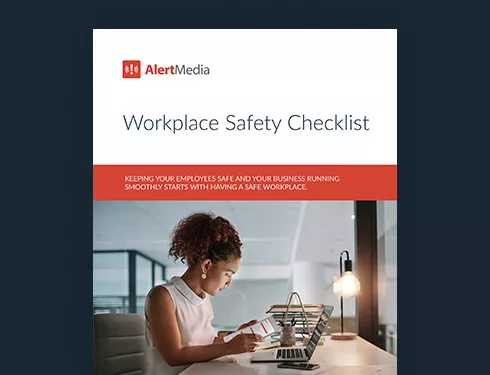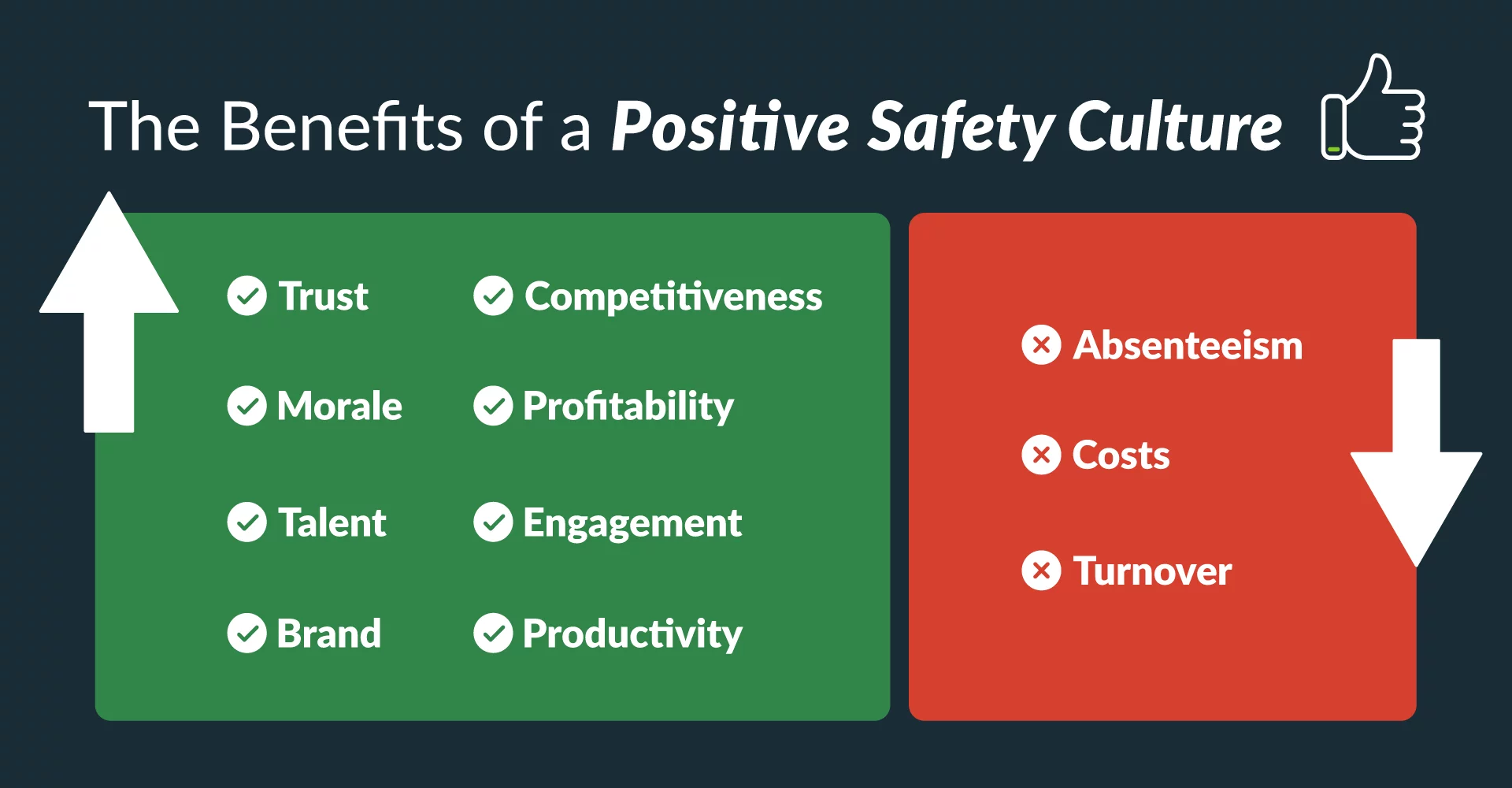
Positive Safety Culture: Your Key to a More Resilient Business
Cultivating a positive safety culture is becoming a top priority for organizations across all sectors. This article will look at what exactly building a positive safety culture means and why it’s so important.

What does workplace safety look like in your organization? Is it annual safety training and thick policy handbooks, or is safety a core value that impacts every aspect of your company’s operations?
For many organizations, safety is no longer seen as a compliance-driven, box-checking exercise—it’s a strategic business imperative with profound bottom-line results.
As companies start to appreciate just how important safety is to their employees, as well as the business, cultivating a positive safety culture is becoming a top priority for organizations across all sectors.
This article will look at what exactly building a positive safety culture means and why it’s so important. We’ll also share what separates companies with strong safety cultures from those without—and actionable steps for developing and maintaining a positive safety culture in your organization.
What Is a Safety Culture?
Safety culture in the workplace refers to the shared attitudes, values, goals, and practices that characterize an organization’s relationship with workplace safety. Both leaders and employees should be committed to the common goal of embedding safety into all aspects of a company’s culture to protect the people, assets, and operations.

Why invest in a safety culture?
An investment in safety is an investment in your organization’s future. Quite simply, organizational success depends on employee health and safety. Whether you’re looking at employee morale and productivity, business resilience, or profitability—it all comes back to safety management.
The AlertMedia State of Employee Safety Report found that 97% of U.S. employees say safety is extremely important to them. But there’s a disconnect: Many U.S. workers believe that their safety is extremely important to their employer. And that’s bad news for employers in today’s competitive labor market, where it’s easy for employees to vote with their feet and find work elsewhere. A great safety culture is one of the most valuable incentives an organization can offer its employees—and it’s essential to attracting and retaining top talent.
Workplace safety culture also impacts the overall resilience of your business. As the number of threats organizations face seems to increase exponentially, business resiliency is becoming critical for long-term success. If your employees are prepared and confident in responding to unforeseen situations or changing risks—your business is far more likely to ride out periods of uncertainty. And while not all workplace accidents or incidents can be prevented, employees should always feel prepared and supported.
While most organizations are already convinced of the value of a strong safety culture from an employee point of view, it’s also important to know how safety initiatives will impact the bottom line. And the business case for safety is clear. Research has found that companies that focus on the well-being and safety of their workforce tend to have a competitive advantage. They also reduce the costs of workplace injuries, which amounted to $163.9 billion in 2020.
How can you distinguish a positive safety culture from a negative one?
You can assess safety culture in different ways depending on your industry. You might observe organizational safety culture through:
- Clear safety procedures
- Active employee participation
- Leadership commitment to safety
- Rigorous safety reporting
- Continuous improvement of safety policies and procedures
Some clues indicate whether your overall company safety culture is positive or, at least, on a positive trajectory. When an organization adopts safety as a core value, metrics like employee morale, productivity, and engagement are likely to be high. The same is true for profitability and brand reputation. Meanwhile, costs related to safety issues decline—as do absenteeism and employee turnover.

As you’re assessing the state of your safety culture, the most valuable information will often come from your employees. When was the last time you surveyed their feelings or thoughts around safety issues? Do staff feel comfortable raising safety concerns with your leadership team?
It can be tricky to define exactly what a positive safety culture looks like because it can vary significantly by industry and organization. But there is one characteristic all companies with a strong safety culture have in common: putting their people first. From relatively safe office-based roles to high-risk construction projects, organizations with a positive safety culture always prioritize their people.
Does Your Organization Reflect a Positive Safety Culture?
Most organizations would say that they at least adhere to health and safety regulations. But from an employee’s perspective, that’s not nearly enough. Employees can tell the difference when their employers comply with procedures because they have to and when an organization chooses to go above the minimum legal requirements, taking a proactive approach to employee safety.
The shift from safety compliance to safety culture happens when business leaders view safety as a core value of their organization—and start to champion safety as the key to sustained organizational success.
These champions are able to ingrain a safety mindset into each and every workplace process, providing employees with a clear frame of reference to help guide their actions. This proactive support empowers employees, reduces workplace anxiety, and gives people the security they need to flourish in their roles.
How To Develop and Maintain Your Safety Culture
Building a culture of safety isn’t a “set-and-forget” initiative. It needs to be proactively incorporated into an organization’s everyday values and behaviors. If you’re ready to improve safety performance, aim to develop a safety management system based on proactive change—rather than reactive responses to near misses.
Developing a positive safety culture
An inclusive and effective safety culture takes time—but it doesn’t need to be complicated. Draw inspiration from other companies with a great approach to safety as you start to develop a similar ethos of your own. We’ve outlined some effective steps to building a safety culture that begin from where you are now.
Evaluate your current position
Audits, data, and assessments can help you discover where you currently stand in terms of safety. There may be specific key risks relevant to your industry, and a threat assessment can help you evaluate their impact. But one of the most valuable ways of assessing your safety culture is to ask your employees.
Gain organizational buy-in
Your employees likely already appreciate the importance of safety because they’re on the front line. But safety needs to be a motivating priority from the top-down. Gaining buy-in from leadership can require some additional conversations—but linking safety goals to business outcomes like profitability and resilience can help reassure leaders that safety should always be a priority.

Make a plan
The time to plan is before an incident, not after. How will you comply with regulations, promote safer working practices, and prepare for potential threats? Involve your employees in the planning stage, and consider how you’ll effectively communicate your plan with all staff, at all locations. A consistent plan will be easier to follow—and help you stay prepared. Building your plan with frameworks like safety change management can make organizational change less disruptive as well.
Set goals
By setting measurable goals, you’ll be able to track your improvements over time. Make sure to link your goals to specific actions, such as reporting safety incidents quickly or implementing monthly safety training sessions. Ask your employees and leaders which goals are most important to narrow in on the outcomes that matter to your team.
Maintaining a positive safety culture
Once you’ve started developing a more positive culture around safety goals, this isn’t something that should be left on the shelf to gather dust. Proactively integrate these safety practices into daily routines to become an effective safety leader.
Communicate
Embedding safety culture into the heart of an organization can take time—and it won’t happen without regular communication. Let your employees know their safety matters by sharing your plan and making them an active part of it. This stage also involves finding ways to communicate quickly and effectively during emergencies—like using two-way emergency communication software.
Train
Research shows that not only do employees want safety training—it also makes them more than 25% more likely to be informed and prepared to act during workplace emergencies. Training shouldn’t just cover basic scenarios like workplace accidents or inclement weather, but also more extreme or industry-specific threats, including workplace violence or cybersecurity breaches. Conducting drills and tabletop exercises are also excellent ways to enhance preparedness for any emergency.
Monitor
A positive and effective safety culture is proactive, not reactive—and that requires a continual assessment of your strengths and weaknesses. Safety culture assessments should be performed at least annually, but preferably bi-annually. Using tools for qualitative analysis like audits and employee surveys—in conjunction with quantitative data like incident and employee absenteeism rates—can help you track and continually improve the effectiveness of your safety program over time.
While monitoring lagging indicators like the frequency of incident reporting is important, champions of safety culture place more importance on tracking leading indicators. Leading indicators—like safety training participation rates and the time it takes to correct safety hazards—signal that a company’s positive safety culture is thriving.
Become a Safety Culture Champion
Cultivating a positive safety culture helps you meet your employees’ number-one priority—a safe work environment. And in a job market with changing priorities, companies can’t afford not to prioritize employees’ top concerns. Employees want to work for organizations that genuinely care about their safety. Your actions show your employees that you care—and creating a positive safety culture is one of the most effective ways you can foster trust.
When building a safety culture, communication is foundational. Clear, timely, and transparent safety communications have a significant impact on helping your employees feel protected at work. By placing employee safety and communication at the center of your organizational values, you can develop a culture based around your most important asset—your people.
No matter what industry you’re in, a successful safety culture relies on swift and effective communication with employees. Whether your employees are threatened by wildfires, hurricanes, or a global pandemic, your people count on you to keep them safe and informed. By leveraging an emergency communication platform like AlertMedia, you can meet your duty of care, provide peace of mind, and create a positive safety culture where safety is a shared priority. And that’s a win-win for your employees—and your business.




